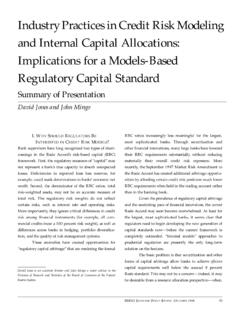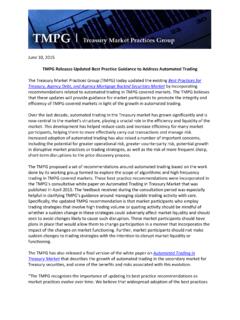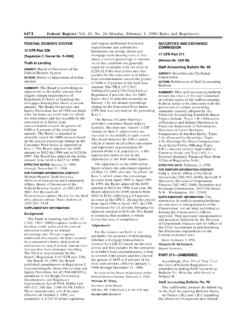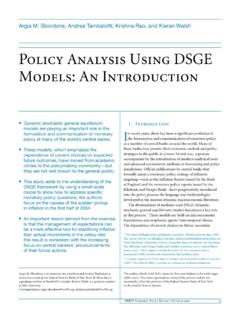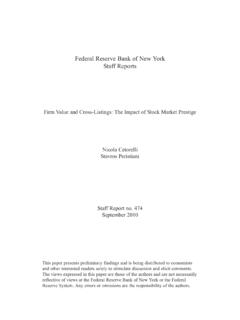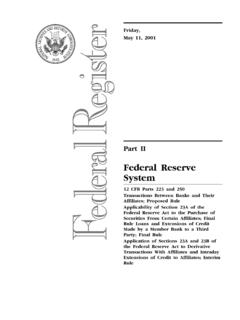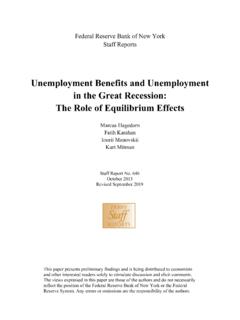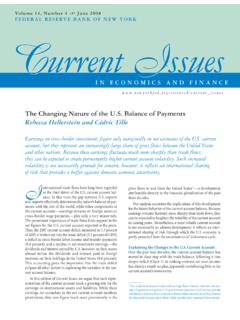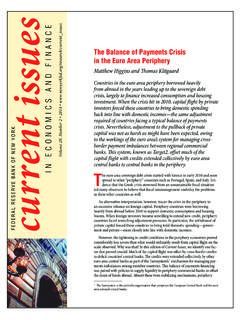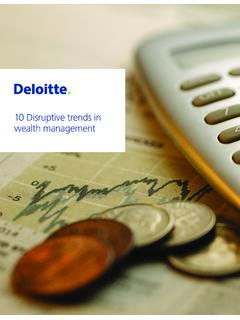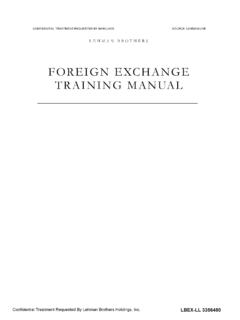Transcription of An Updated User’s Guide to SOFR - Federal Reserve Bank ...
1 An Updated User's Guide to SOFR. The Alternative Reference Rates Committee February 2021. 1. Executive Summary This note is intended to help explain how market participants can use SOFR in cash products. The ARRC has stated that those who are able to use SOFR should not wait for forward-looking term rates in order to transition, and the note lays out a number of considerations that market participants interested in using SOFR will need to consider: Financial products either explicitly or implicitly use some kind of average of SOFR, not a single day's reading of the rate, in determining the floating-rate payments that are to be paid or received.
2 An average of SOFR will accurately reflect movements in interest rates over a given period of time and smooth out any idiosyncratic, day-to-day fluctuations in market rates. Issuers and lenders will face a technical choice between using a simple or a compound average of SOFR as they seek to use SOFR in cash products. In the short-term, using simple interest conventions may be easier since many systems are already set up to accommodate it. However, compounded interest would more accurately reflect the time value of money, which becomes a more important consideration as interest rates rise, and it can allow for more accurate hedging and better market functioning.
3 Users need to determine the period of time over which the daily SOFRs are observed and averaged. An in advance structure would reference an average of SOFR observed before the current interest period begins, while an in arrears structure would reference an average of SOFR over the current interest period. SOFR in advance is operationally easier to implement, but SOFR in arrears will reflect movements in rates contemporaneously. An average of SOFR in arrears will reflect what actually happens to interest rates over the period; however it provides very little notice before payment is due.
4 There have been a number of conventions designed to allow for a longer notice of payment within the in arrears framework. These include payment delays, lookbacks, and lockouts, and, as described in the note, different markets have successfully adopted each of these. The note also discusses conventions for in advance payment structures and hybrid models that can substantially reduce the basis relative to in arrears while still providing borrowers the same length of notice that they have with LIBOR. The note also explains the interaction between SOFR and the type of forward-looking term rates that the ARRC has set a goal of seeing produced once SOFR derivative markets develop sufficient depth.
5 While these term rates can be a useful tool for some and an integral part of the new ecosystem, hedging these rates will also tend to entail more costs than using SOFR directly and their use must be consistent with the functioning of the overall financial system. For this reason, the ARRC sees some specific productive uses for a forward-looking SOFR term rate, in particular as a fallback for legacy cash products referencing LIBOR and in loans where the borrowers otherwise have difficulty adapting to the new environment.
6 2. Background In 2014, the Federal Reserve convened the Alternative Reference Rates Committee (ARRC) and tasked the group with identifying an alternative to dollar LIBOR that was a robust, IOSCO- compliant, transaction-based rate derived from a deep and liquid market. In 2017, the ARRC fulfilled this mandate by selecting the Secured Overnight Financing Rate, or SOFR. SOFR is based on overnight transactions in the dollar Treasury repo market, the largest rates market at a given maturity in the world. National working groups in other jurisdictions have similarly identified overnight nearly risk-free rates (RFRs) like SOFR as their preferred alternatives.
7 SOFR has a number of characteristics that LIBOR and other similar rates based on wholesale term unsecured funding markets do not: It is a rate produced by the Federal Reserve Bank of New York for the public good;. It is derived from an active and well-defined market with sufficient depth to make it extraordinarily difficult to ever manipulate or influence;. It is produced in a transparent, direct manner and is based on observable transactions, rather than being dependent on estimates, like LIBOR, or derived through models; and It is derived from a market that was able to weather the global financial crisis and that the ARRC credibly believes will remain active enough in order that it can reliably be produced in a wide range of market conditions.
8 However, SOFR is also new, and many are unfamiliar with how to use it. SOFR is also an overnight rate, and while the ARRC believes that most market participants can adapt to this by using compound or simple averaging over the relevant term, the ARRC has at the same time set a goal of seeing an administrator produce a forward-looking term rate based on SOFR derivatives (once these markets develop to sufficient depth) in order to aid those cash market participants who may have greater difficulty in adapting to an overnight rate.
9 The national working groups in the other currency jurisdictions each independently reached the same conclusion that there were no viable robust term rate alternatives to LIBOR. Like the ARRC, each has chosen either an unsecured or secured overnight rate, depending on the characteristics of their national markets (see Table 1). 1. Table 1: Selected RFRs Dollar SOFR Overnight secured repo rate Sterling SONIA Overnight unsecured rate Japanese Yen TONA Overnight unsecured rate Euro ESTER Overnight unsecured rate Swiss Franc SARON Overnight secured repo rate 1 Further information on the work of each of the national working groups in other currency jurisdictions can be found in the FSB's Progress Report on Reforming Major Interest Rate Benchmarks, October 2017.
10 3. This note is intended to help explain how market participants can use SOFR in cash products and to explain the forward-looking term rates the ARRC seeks to see published in the future and where the ARRC believes those rates can be most productively used. The term rates can be a useful tool for some and an integral part of the new ecosystem; but their use also needs to be consistent with the functioning of the overall financial system. In particular, those who are able to use SOFR should not wait for the term rates in order to transition.
